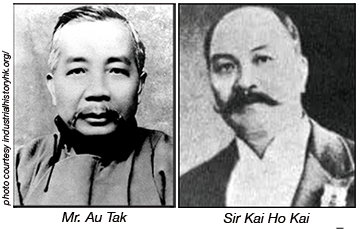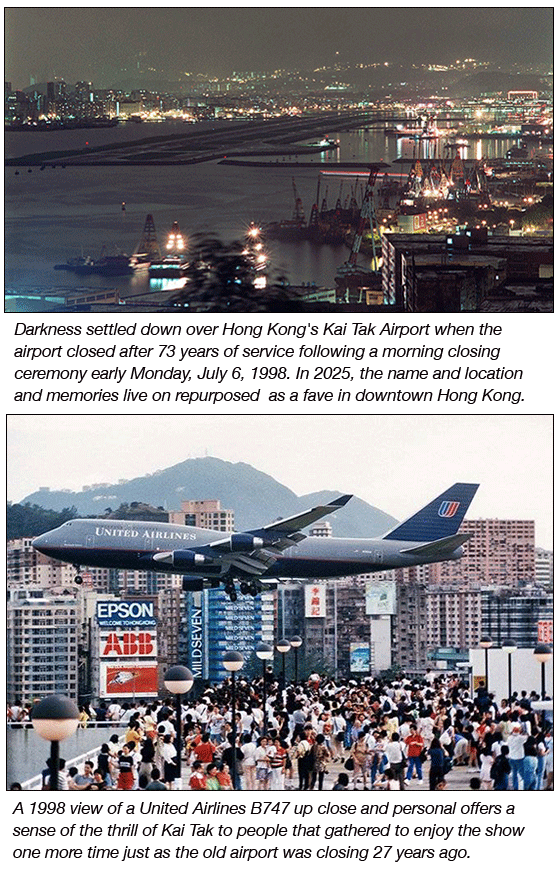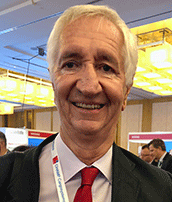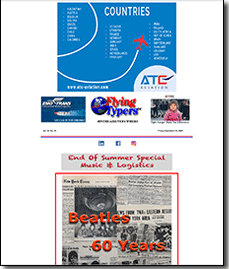|
 March 30th 2025 marked the hundredth anniversary of the creation of Kai Tak Airport in Hong Kong. March 30th 2025 marked the hundredth anniversary of the creation of Kai Tak Airport in Hong Kong.
It was back in 1925 when two businessmen, Sir Kai Ho Kai and Mr. Au Tak with incredible foresight created Hong Kong's first-land based airport.
Actually, at that time the primary means of air transport was by the flying boats, both east and west, with BOAC running flights to London and Pan-American across the Pacific.
The last long-distance flying boat service departed Hong Kong in 1958 though Cathay Pacific continued to run Grumman Mallards across the Pearl River to Macau which had no land-based airport for some years after that.
I never witnessed these operations but I do recall, when sitting for my HK Marine Dept pleasure vessel skippers license in 1975, some of the vessel lighting configurations I had to memorize were for flying boats.
 |
By the time I arrived in Hong Kong in 1975, Kai Tak had already arrived in the jet age, with even a smattering of widebody aircraft to be seen. And despite the cramped nature of the airport, sandwiched between the harbor, the Nullah and the densely populated neighborhoods, Kai Tak was becoming a significant aviation hub.
The Nullah, a creek that ran alongside the runway was made famous in James Clavell’s “Taipan” novel, wherein an arriving passenger turns to a seat mate asking about the source of the smell that has just invaded the cabin after landing and is told:
“That’s the smell of money!”
By any measure The Nullah certainly had a distinct aroma especially during the long hot summer.
In my more, crazy youthful days I enjoyed “skydiving” and Hong Kong actually had in those days a small flying club located right beside the airport with a couple of Cessna aircraft.
On any Saturday morning, we would assemble at the club with our gear, load up into the aircraft with the door off.
As the airport opened at 7:00 am, lifting the flight curfew, we would taxi out onto the runway, quite often right behind a Cathay Pacific Tristrar or Convair, take off and fly north over the new territories jumping above the Shek Kong military airfield (now a PLA airfield).
We could generally pack in a couple of jumps, and after the last one, the aircraft would fly back to Kai Tak empty to land there before 10:30 when we had to deliver the aircraft for other duties.
Kai Tak always was an airport where too much was never enough; a scene of constant construction, including a road tunnel that ran directly under the runway; the enormous Hactl cargo terminals over on the eastern side, and the long row of Haeco Hangars,
The action was everywhere, including on the parking apron that squeezed every inch of space for operations. One could drive around the perimeter road so close to the action with 747s parked just on the other side of a fence.
And of course, one cannot ignore the waters around the unique runway which jutted out into the harbor.
Any kind of waterborne activity at the eastern end of the harbor was accompanied by the thunder of 747’s taking off right overhead.
One of the more memorable experiences was the visit of Concorde to Hong Kong.
But perhaps my very best memories of Hong Kong were jump seat landings and takeoffs.
During those days it was not unusual for one to know the captain on a Cathay flight and all it took was a word to the flight staff onboard and one would be strapping in on a cockpit jump seat for take offs or landings.
My last ever landing into Kai Tak was on a Cathay 747 from Tokyo one evening.
 As it happened, it was also the first officers last ever landing into Kai Tak and he savored every moment of it as did I. As it happened, it was also the first officers last ever landing into Kai Tak and he savored every moment of it as did I.
Nighttime arrivals were particularly spectacular tracking the row of strobes across Kowloon before turning at the chequer board.
A few days later Kai Tak closed its doors for the last time, and the steady stream of aircraft descending into the airport across Kowloon, which I could view from my office window was no more.
Today Kai Tak is home to a huge Cruise Terminal, some massive housing, and the amazing new 60,000 seat Kai Tak stadium, as once again Hong Kong repurposes itself, and of course the current airport out at Chep Lap Kok is a marvel in itself.
But for those of us who were around during those Kai Tak days will always have very fond memories of a place in history created by Mr. Kai and Mr. Tak.
Bob Rogers
|




 Vol. 24. No. 40
Vol. 24. No. 40